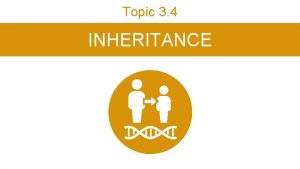Screening for Respiratory Ciliary Dysfunction in Autosomal Recessive

- Slides: 1

Screening for Respiratory Ciliary Dysfunction in Autosomal Recessive Polycystic Kidney Disease Root H 1, Gunay-Aygun M 2, Holland SM 1, Olivier KN 1 1 Laboratory of Clinical Infectious Diseases, National Institute of Allergy and Infectious Diseases and 2 Medical Genetics Branch, National Human Genome Research Institute, Bethesda, MD Background Autosomal recessive polycystic kidney disease (ARPKD) is a rare sensory ciliopathy characterized by enlarged kidneys due to renal cysts and associated congenital hepatic fibrosis (CHF). 1 Recent data have suggested a possible connection between sensory ciliopathies and respiratory ciliary dysmotility. Bronchiectasis was seen on chest CT scans in 37% of autosomal dominant polycystic kidney disease patients vs. 12% of control chronic kidney disease patients suggesting possible respiratory ciliary abnormalities. 2 In vivo measurement of nasal nitric oxide (n. NO) production has been used as an easily performed, sensitive screen for primary ciliary dyskinesia (PCD). Results Summary Table 1. Respiratory Symptoms of ARPKD Patients n. No Values # Age (n. L/min) Neonatal Respiratory Distress Pneumothorax at History of Lower Respiratory Epistaxis Otitis Media Birth Asthma Infections 1 33 108. 8 2 6 115. 3 PET* (1) 3 12 132. 3 X PET* (3) 4 5 136. 2 premature birth X X Objectives 5 6 136. 2 6 9 138. 8 To screen for respiratory ciliary dysfunction in ARPKD by assessing n. NO production and to look for evidence of respiratory tract abnormalities in ARPKD patients. 7 4 151. 6 8 4 155. 8 9 14 165. 7 10 15 172. 2 11 29 174. 1 X 12 18 178. 1 13 5 179. 9 X X 14 13 180. 7 X 15 182. 1 premature birth X PET* (2) 16 13 198 17 28 199. 7 18 28 200. 1 19 9 215. 6 X 20 8 222. 4 21 18 243. 6 X 22 11 249. 6 premature birth 23 10 261 24 10 267. 7 25 10 290. 5 premature birth X X 26 50 329. 3 27 33 353 28 373 Methods Records of patients enrolled in a natural history study of ARPKD/CHF at the NIH were reviewed for a history of respiratory symptoms and/or respiratory tract infections, prior pulmonary function test results, and chest imaging. Sampling of n. NO was performed through a foam nasal probe during exhalation through a resistor and was measured in real-time via a Ni. Ox (Aerocrine) chemiluminescense analyzer. Values from ARPKD patients were compared to the n. NO measurements from healthy volunteers. • The average and n. NO of the ARPKD patients (n=28) were 15±(SEM)2 years and 204± 13 n. L/min respectively compared to 32± 2 years (p<0. 0001) and 289± 16 n. L/min (p<0. 0001) in the NIAID controls (n=25) and 14± 1 years (p>0. 7) and 272± 11 n. L/min (p<. 0008) in the UNC controls (n=79). 6 7 • Six ARPKD patients (21%) had a history of recurring respiratory tract infections including 3 out of 4 with otitis media requiring myringotomy tubes (n. NO: 115, 132, 182 n. L/min). • Air trapping on lung volume measurements was noted in 8 (n=22, 36%) and abnormal diffusion was noted in 16 (n=21, 76%) patients. • Three patients had available high resolution chest CT scans; no evidence of bronchiectasis was seen. X Figure 1. Nasal Nitric Oxide Levels in ARPKD patients and 2 sets of controls: healthy volunteers from NIAID (age 32± 2 years) and from UNC (age 14± 1). Conclusions • None of the ARPKD patients had n. NO levels in the range seen with PCD (<100 n. L/min). X • However, the values were significantly lower than both older, same-site controls and age appropriate controls from UNC with lower levels in those with more respiratory problems. • Respiratory infections and respiratory tract abnormalities in ARPKD indicate further investigation of respiratory ciliary dysfunction is warranted. X References 1. Harris PC, Torres VE. Polycistic Kidney Disease. Annu. Rev. Med. 2009. 60: 321 -37. *PET = Pressure Equalization Tubes X Figure 2. Lung Function Tests results of ARPKD patients. These are the % predicted values of Forced Expiratory Volume in 1 second (FEV 1), Total Lung Capacity (TLC) and Diffusing Capacity of the Lung for Carbon Monoxide (DLCO). 2. Driscoll JA, Bhalla S, Liapis H, Ibricevic A, Brody SL. Autosomal Dominant Polycistic Kidney Disease is Associated with an Increased Prevalence of Radiographic Bronchiectasis. 2008. Chest. 133: 1181 -1188. Supported in part by intramural funds of the NIAID and NHGRI and by the Genetic Diseases of Mucociliary Clearance Consortium, NIH 9 U 54 HL 096458 -06 funded by Office of the Director, and supported by ORDR and NHLBI, NIH.

